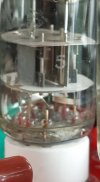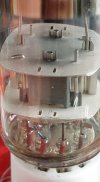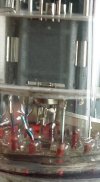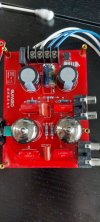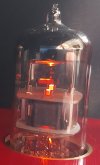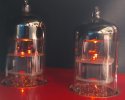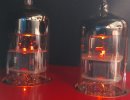-
Welcome to ASR. There are many reviews of audio hardware and expert members to help answer your questions. Click here to have your audio equipment measured for free!
You are using an out of date browser. It may not display this or other websites correctly.
You should upgrade or use an alternative browser.
You should upgrade or use an alternative browser.
My pre-built ish Tube amp what is it comparable to these days ?
- Thread starter Earwax
- Start date
Earwax
Active Member
- Thread Starter
- #3
Found my purchase history bought it in the year 2016 Taxes in $47 Canadian.
Mine was before the transformer protective box I only have what is in my pictures bare transformer.... & I don`t have the green leds on the bottom thankfully...
Product descriptions:
Introduction This tube preamp is based on the famous Matisse circuit, some modifications have been applied to expand the range of frequency, it sounds smooth and punchy. It's built up with 2 PCBs, the thickness of the lower main circuit PCB is 2mm which can avoid damage when replacing tubes, the upper PCB is for shielding and protection, excellent design!
Features Components: Selected 6N3 tube, Panasonic high voltage capacitors, special ordered high voltage out-couling capacitors, 1% tolerance metal film resistors, quality sealed mini potentiometers.
Glass fiber golden board, red solder mask, with green LEDs on the bottom of the tubes which give a fascinating looking in the dark!
The kit is prewired and well set, you can use it directly even without a case Overall Dimension (including posts, front knob and RCA sockets): 125mm(length) x 115mm(width) x 73mm (thickness) Approx. 3 times amplifier.
Mine was before the transformer protective box I only have what is in my pictures bare transformer.... & I don`t have the green leds on the bottom thankfully...
Product descriptions:
Introduction This tube preamp is based on the famous Matisse circuit, some modifications have been applied to expand the range of frequency, it sounds smooth and punchy. It's built up with 2 PCBs, the thickness of the lower main circuit PCB is 2mm which can avoid damage when replacing tubes, the upper PCB is for shielding and protection, excellent design!
Features Components: Selected 6N3 tube, Panasonic high voltage capacitors, special ordered high voltage out-couling capacitors, 1% tolerance metal film resistors, quality sealed mini potentiometers.
Glass fiber golden board, red solder mask, with green LEDs on the bottom of the tubes which give a fascinating looking in the dark!
The kit is prewired and well set, you can use it directly even without a case Overall Dimension (including posts, front knob and RCA sockets): 125mm(length) x 115mm(width) x 73mm (thickness) Approx. 3 times amplifier.
Last edited:
somebodyelse
Master Contributor
- Joined
- Dec 5, 2018
- Messages
- 5,314
- Likes
- 4,899
If you mean the heaters it doesn't matter much whether they've fed AC or DC.What I`m most confused about is the DC powered mini Tube amps I`m seeing as mine is AC through the tubes :-/
DVDdoug
Major Contributor
- Joined
- May 27, 2021
- Messages
- 4,443
- Likes
- 6,113
I'm not following that... Are you saying it messes-up the sound in a way that you like? That can happen but if a tube amp has a particular "sound", a different tube amp will sound different so it may be hard to find you you like.*The Tube pre amp I`m using above is absolutely removing the higher frequency harmonics making songs like Van Halen don`t tell me what love can do Guitar so Pure sounding....'
A good tube amp has the same characteristics as a good solid state amp - Low distortion, low noise, and flat frequency response. It's job is simply to amplify. Most amplifiers achieve that, but it's more expensive to make a good tube amp so you are more likely to get an "imperfect" tube amp Good tube power amps get very expensive per-watt.
I'm not going to watch the video. If it's a good design and the tube is correct and in-spec, swapping tubes shouldn't change anything. A good design is tolerant of component variations. Transistors have tolerances too but they don't age like tubes. The characteristics of transistors & MOSFETs usually don't change until they suddenly die.When does swapping Tubes become noticeable, quickly gives insight to the cross talk we all hear so much. Simplicity wins ?
* Guitar players often prefer tube amps for they way they distort/saturate when over driven. And since no two amps distort in exactly the same way, they often have their favorite guitar and their favorite amp. Hi-fi amps are supposed to amplify cleanly and you're not supposed to over-drive them into clipping.
Earwax
Active Member
- Thread Starter
- #13
In the Types Of Vacuum Tubes section at the 2:50 mark appears to state the way Tubes change the flow of electrons affecting the High or Low frequencies. It seems that the specific design of the internal Grid is what is making tubes sound different, there is more than a few way to design these grids and that is very interesting.
Earwax
Active Member
- Thread Starter
- #14
It now appears to me that a taller tube vs a short tube could also influence the frequencies passing through it ? Combining the Grid designs & or cathode size with that and finally a real discussion could start for People with actual circuit design history to now explain to us less fortunate people who have no such gifts just how different tube designs change the frequencies ...
Last edited:
Soandso
Addicted to Fun and Learning
- Joined
- May 30, 2022
- Messages
- 833
- Likes
- 2,477
For several years now my understanding has been that the particular quality of a vacuum tube amplifier's transformer had more significance for the audio quality than any tube rolling for that particular amp design. Below is an edited synopsis of cited website screen shots.



solderdude
Grand Contributor
A 50k 'passive volume control' on the output may not be a great idea.
What's a bit puzzling is the component count versus the schematic above (3x gain with overall feedback) so the amp schematic above may not be correct (seems some resistors are 'missing')
The power supply schematic is correct though.
The component count suggests a cathode follower.
Last edited:
- Joined
- Jul 21, 2019
- Messages
- 3,017
- Likes
- 4,392
It's nothing that an opamp line driver couldn't solveA 50k 'passive volume control' on the output may not be a great idea.
The signal part on yours is DC. As somebodyelse pointed out some use DC for the low voltage heaters. The main advantage there is keeping A/C and the magnetic fields it generates away from the amplification.What I`m most confused about is the DC powered mini Tube amps I`m seeing as mine is AC through the tubes :-/
I haven't watched the video either, however from the thumbnail, he is showing different models of tubes and not just different brands. The different models of tubes will have different ideal operating currents, voltages and even output transformer specs. Swapping those in has a very good chance of affecting the performance and thus the sound. If the amp was designed for one of the higher powered tubes then it could kill the lower power ones to run it at those levels..... I'm not going to watch the video. If it's a good design and the tube is correct and in-spec, swapping tubes shouldn't change anything. A good design is tolerant of component variations. Transistors have tolerances too but they don't age like tubes. The characteristics of transistors & MOSFETs usually don't change until they suddenly die.
Basically it has far too much gain so the high impedance pot coupled output throws away a bunch of that gain. It has nothing in common with the Matisse circuit aside from using tubes. That is a HUGE output capacitor - you definitely wouldn't want to turn this on when your amp is already on.View attachment 438845
View attachment 438846
A 50k 'passive volume control' on the output may not be a great idea.
What's a bit puzzling is the component count versus the schematic above (3x gain with overall feedback) so the amp schematic above may not be correct (seems some resistors are 'missing')
The power supply schematic is correct though.
The component count suggests a cathode follower.
Similar threads
- Replies
- 6
- Views
- 571
- Replies
- 23
- Views
- 2K
- Replies
- 33
- Views
- 2K
- Replies
- 8
- Views
- 693
